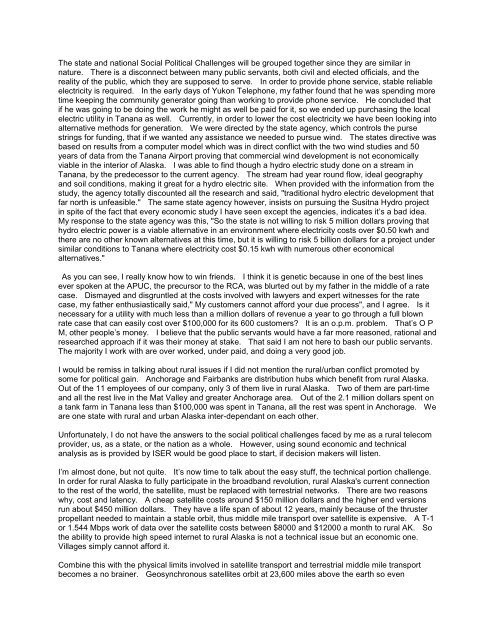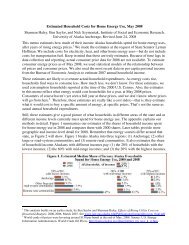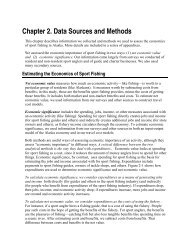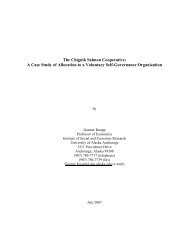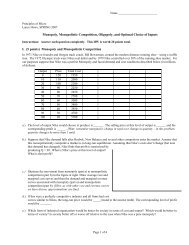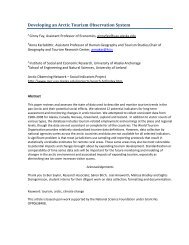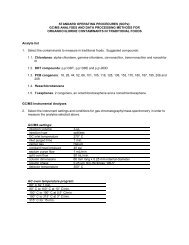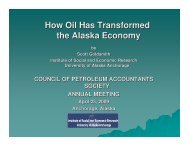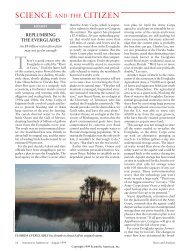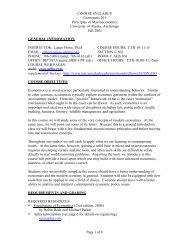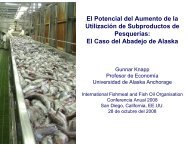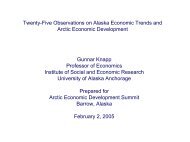Good Afternoon, My name is Don Eller. I was born and raised in ...
Good Afternoon, My name is Don Eller. I was born and raised in ...
Good Afternoon, My name is Don Eller. I was born and raised in ...
You also want an ePaper? Increase the reach of your titles
YUMPU automatically turns print PDFs into web optimized ePapers that Google loves.
The state <strong>and</strong> national Social Political Challenges will be grouped together s<strong>in</strong>ce they are similar <strong>in</strong><br />
nature. There <strong>is</strong> a d<strong>is</strong>connect between many public servants, both civil <strong>and</strong> elected officials, <strong>and</strong> the<br />
reality of the public, which they are supposed to serve. In order to provide phone service, stable reliable<br />
electricity <strong>is</strong> required. In the early days of Yukon Telephone, my father found that he <strong>was</strong> spend<strong>in</strong>g more<br />
time keep<strong>in</strong>g the community generator go<strong>in</strong>g than work<strong>in</strong>g to provide phone service. He concluded that<br />
if he <strong>was</strong> go<strong>in</strong>g to be do<strong>in</strong>g the work he might as well be paid for it, so we ended up purchas<strong>in</strong>g the local<br />
electric utility <strong>in</strong> Tanana as well. Currently, <strong>in</strong> order to lower the cost electricity we have been look<strong>in</strong>g <strong>in</strong>to<br />
alternative methods for generation. We were directed by the state agency, which controls the purse<br />
str<strong>in</strong>gs for fund<strong>in</strong>g, that if we wanted any ass<strong>is</strong>tance we needed to pursue w<strong>in</strong>d. The states directive <strong>was</strong><br />
based on results from a computer model which <strong>was</strong> <strong>in</strong> direct conflict with the two w<strong>in</strong>d studies <strong>and</strong> 50<br />
years of data from the Tanana Airport prov<strong>in</strong>g that commercial w<strong>in</strong>d development <strong>is</strong> not economically<br />
viable <strong>in</strong> the <strong>in</strong>terior of Alaska. I <strong>was</strong> able to f<strong>in</strong>d though a hydro electric study done on a stream <strong>in</strong><br />
Tanana, by the predecessor to the current agency. The stream had year round flow, ideal geography<br />
<strong>and</strong> soil conditions, mak<strong>in</strong>g it great for a hydro electric site. When provided with the <strong>in</strong>formation from the<br />
study, the agency totally d<strong>is</strong>counted all the research <strong>and</strong> said, "traditional hydro electric development that<br />
far north <strong>is</strong> unfeasible." The same state agency however, <strong>in</strong>s<strong>is</strong>ts on pursu<strong>in</strong>g the Susitna Hydro project<br />
<strong>in</strong> spite of the fact that every economic study I have seen except the agencies, <strong>in</strong>dicates it’s a bad idea.<br />
<strong>My</strong> response to the state agency <strong>was</strong> th<strong>is</strong>, "So the state <strong>is</strong> not will<strong>in</strong>g to r<strong>is</strong>k 5 million dollars prov<strong>in</strong>g that<br />
hydro electric power <strong>is</strong> a viable alternative <strong>in</strong> an environment where electricity costs over $0.50 kwh <strong>and</strong><br />
there are no other known alternatives at th<strong>is</strong> time, but it <strong>is</strong> will<strong>in</strong>g to r<strong>is</strong>k 5 billion dollars for a project under<br />
similar conditions to Tanana where electricity cost $0.15 kwh with numerous other economical<br />
alternatives."<br />
As you can see, I really know how to w<strong>in</strong> friends. I th<strong>in</strong>k it <strong>is</strong> genetic because <strong>in</strong> one of the best l<strong>in</strong>es<br />
ever spoken at the APUC, the precursor to the RCA, <strong>was</strong> blurted out by my father <strong>in</strong> the middle of a rate<br />
case. D<strong>is</strong>mayed <strong>and</strong> d<strong>is</strong>gruntled at the costs <strong>in</strong>volved with lawyers <strong>and</strong> expert witnesses for the rate<br />
case, my father enthusiastically said," <strong>My</strong> customers cannot afford your due process", <strong>and</strong> I agree. Is it<br />
necessary for a utility with much less than a million dollars of revenue a year to go through a full blown<br />
rate case that can easily cost over $100,000 for its 600 customers? It <strong>is</strong> an o.p.m. problem. That’s O P<br />
M, other people’s money. I believe that the public servants would have a far more reasoned, rational <strong>and</strong><br />
researched approach if it <strong>was</strong> their money at stake. That said I am not here to bash our public servants.<br />
The majority I work with are over worked, under paid, <strong>and</strong> do<strong>in</strong>g a very good job.<br />
I would be rem<strong>is</strong>s <strong>in</strong> talk<strong>in</strong>g about rural <strong>is</strong>sues if I did not mention the rural/urban conflict promoted by<br />
some for political ga<strong>in</strong>. Anchorage <strong>and</strong> Fairbanks are d<strong>is</strong>tribution hubs which benefit from rural Alaska.<br />
Out of the 11 employees of our company, only 3 of them live <strong>in</strong> rural Alaska. Two of them are part-time<br />
<strong>and</strong> all the rest live <strong>in</strong> the Mat Valley <strong>and</strong> greater Anchorage area. Out of the 2.1 million dollars spent on<br />
a tank farm <strong>in</strong> Tanana less than $100,000 <strong>was</strong> spent <strong>in</strong> Tanana, all the rest <strong>was</strong> spent <strong>in</strong> Anchorage. We<br />
are one state with rural <strong>and</strong> urban Alaska <strong>in</strong>ter-dependant on each other.<br />
Unfortunately, I do not have the answers to the social political challenges faced by me as a rural telecom<br />
provider, us, as a state, or the nation as a whole. However, us<strong>in</strong>g sound economic <strong>and</strong> technical<br />
analys<strong>is</strong> as <strong>is</strong> provided by ISER would be good place to start, if dec<strong>is</strong>ion makers will l<strong>is</strong>ten.<br />
I’m almost done, but not quite. It’s now time to talk about the easy stuff, the technical portion challenge.<br />
In order for rural Alaska to fully participate <strong>in</strong> the broadb<strong>and</strong> revolution, rural Alaska's current connection<br />
to the rest of the world, the satellite, must be replaced with terrestrial networks. There are two reasons<br />
why, cost <strong>and</strong> latency. A cheap satellite costs around $150 million dollars <strong>and</strong> the higher end versions<br />
run about $450 million dollars. They have a life span of about 12 years, ma<strong>in</strong>ly because of the thruster<br />
propellant needed to ma<strong>in</strong>ta<strong>in</strong> a stable orbit, thus middle mile transport over satellite <strong>is</strong> expensive. A T-1<br />
or 1.544 Mbps work of data over the satellite costs between $8000 <strong>and</strong> $12000 a month to rural AK. So<br />
the ability to provide high speed <strong>in</strong>ternet to rural Alaska <strong>is</strong> not a technical <strong>is</strong>sue but an economic one.<br />
Villages simply cannot afford it.<br />
Comb<strong>in</strong>e th<strong>is</strong> with the physical limits <strong>in</strong>volved <strong>in</strong> satellite transport <strong>and</strong> terrestrial middle mile transport<br />
becomes a no bra<strong>in</strong>er. Geosynchronous satellites orbit at 23,600 miles above the earth so even


